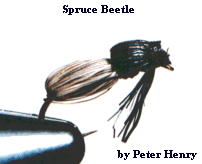Spruce Beetle

Tied by Peter Henry, pdhenry@aries.for.gov.bc.ca
PATTERN:
Hook: Mustad 94845 or equivalent
Size: 14-18
Thread: Black 6/0
Body: Rear 3/5's natural deer body hair
Front 2/5's black deer body hair and tying thread
Tying instructions:
Start the thread and wrap to the bend. Stack some natural
deer hair and tie in by the tips (butts facing away from the eye). Try
to spread the hair evenly around the hook shank to prevent gaps in
the body (usually occur underneath the hook). Move the thread
forward 3/5's of the way to the eye. Pull the deer hair forward and
fasten so that the posterior end of the body is plump and rounded.
Trim the excess hair. Wrap the tying thread to the eye and back to
cover all of the butts of the natural colour hair and to create a
tapered thread body. Stack some black deer hair and tie in by the
tips (butts facing away from the eye). Try to spread the black hair
around the top half of the hook shank. Wrap the thread forward to
the eye. Pull the black deer hair over and fasten with two or three
wraps of tying thread just behind the eye. Pull 6-8 hairs from the
bottom of the bundle down and to the rear to form legs (I used a
bodkin to separate the hairs). Take two or three more wraps in the
same place to secure the legs to the read and then whip finish and
cement. Trim the legs to about 1/2 the hook shank in length (looks
best with different length legs). Trim the butts from the front of the
body by cutting them off at an angle (like an elk hair caddis).
Spruce Beetle Information
The spruce beetle (Dendroctonus rufipennis) is a pest of spruce
trees throughout the range of spruce in North America. There are
currently severe infestations in the southeast Yukon and southwest
Alaska (particularly the Kenai Peninsula). The Yukon infestation
covers more than 50,000 acres and the Alaskan infestation I believe is
over 150,000 acres. This imitation was designed to immitate the adult
spruce beetle.
The beetles feed on the cambium of spruce trees eventually
killing the tree. The adult beetles fly in June (in BC, Yukon, Alaska)
to mate and find a new host. Until recently I lived in the Yukon and I
tied this fly to use for Rainbows, Grayling and Dolly Varden in the
Yukon. When the mating flight occurs these beetles are probably
the most numerous terrestrials available in the southeast Yukon.
Fish the fly with a dead drift.
BACK TO TFS

